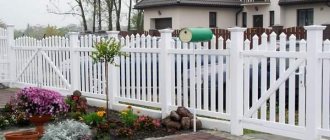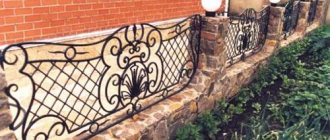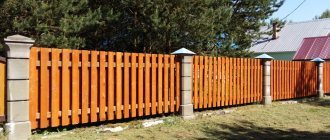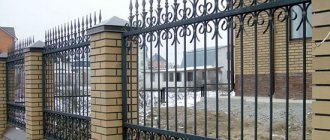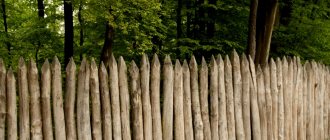Types of fences and barriers for the front garden of a private house
There is a variety of materials that are used to create fences. They are all different:
- operational life;
- difficulty in care;
- ease of work;
- cost.
Styling is of great importance. It is important that all the details on the front garden are combined with each other and have a complete appearance. We have made a selection of the most popular materials from which a decorative fence for the front garden in front of the house will look best. We will also consider the main points of creating such fences with your own hands.
Fence for front garden made of metal and mesh
Iron fences have an “airy” appearance; they do not burden the landscape design and guarantee visual appeal. The simplest option is to install a chain-link mesh. To prevent it from corroding, it is better to buy galvanized or plasticized options.
Photo of a metal fence for the front garden
It is necessary to install metal posts or a frame at an identical distance on which the mesh will be hung. For work it is better to use welding. The frame is an important detail that ensures that the mesh does not deform. Now all that remains is to paint the chain-link (if desired) or plant climbing crops nearby, which will create the effect of a hedge.
You can also choose a more expensive option - forged. Such fences are produced in solid sections connected by welding. The decor is fastened in spans; welding is also used for the work. Most often, forged options are ordered from specialists, since without certain skills you will not be able to make a beautiful fence on your own.
Original wooden fence for the front garden
Wood is a natural and attractive material that has visual appeal, wooden structures are easy to create and install. Before you make a fence for the front garden with your own hands from wood, do not forget to buy the following materials:
- boards of identical size;
- nails;
- circular dust;
- carpentry set.
- pillars.
The process of creating a fence is as follows:
Construction of a wooden fence
- First, we decide on the design of the fence and draw a drawing.
- We create holes for supports. Then we install the support bars inside, fixing them at an identical distance from each other.
- We check that the posts are installed correctly, level them and fill them with cement mortar.
- We proceed to installing the crossbars, marking the places where the boards or picket fence will be attached.
- We nail the boards to the crossbars.
- We paint or varnish the fence at our discretion.
When creating such a fence, keep in mind that the picket fences are positioned horizontally or vertically. It depends on the aesthetic preferences of the owners.
Low wicker fences for the front garden
The fence around the front garden can be made of a small height using weaving techniques. For work, a vine is prepared that can be weaved, and thick branches, cleared of bark, are used as the base.
First you need to firmly strengthen the branches in the ground, and only then entwine them with vines. The advantage of the vine is that it does not need to be specially processed or painted. The structure can be supplemented with beautifully decorated tree stumps installed on the site and original figures carved from wood.
Fence for the front garden made of Euro picket fence
Euro picket fences are strips of metal, the width of which is 0.1 meter and the length is from 150 to 300 cm. To produce such strips, sheets of galvanized steel are used, sometimes they can be coated with a polymer layer that will protect from various external influences. Having purchased such strips, you can install them yourself using the following technology:
Installation diagram of a fence made of Euro picket fence
- First, support pillars are installed (they are usually made of profile pipe, but brick structures can also be used). Drive the post 120 cm deep, and if the soil is very loose, reinforce the base with concrete.
- Secure plastic caps to the ends of the pipes to prevent rainwater from getting inside.
- Proceed to installing the transverse pipes, and mask the seams that remain from welding with paint or primer.
European picket fence manufacturers recommend installing no more than 9 panels per 1 m of fence. The height can be adjusted, but usually it is 180-240 cm. Pickets can be installed with a small gap - up to 2 cm or checkerboard (when the gap overlaps on the other side of the picket). If desired, the fence can be supplemented with a ridge strip, which will add originality to the product.
Beautiful fence for the front garden with your own hands from a professional pipe
To build a fence, take measurements, make a drawing or diagram of what the structure should look like. This will allow you to calculate how much material will be needed. To create it you will also need to take:
- pipes 10 mm thick (they will be vertical crossbars);
- pipes serving as load-bearing supports - diameter 5 cm;
- horizontal pipes (width 4-5 cm);
- cement, sand, crushed stone;
- welding, grinder, drill, shovel, construction. level, square, plumb.
To ensure that the fence is even, tighten the thread before installing it. If you plan to lay a strip foundation, then you will need to dig a trench. Next you need to perform the following steps:
Drawing of a fence made from a 20x20 profile
- Cut 60x60 pipes with a grinder to get the same length. They will serve as pillars. We weld mounting strips to them.
- Then we fill the holes or trenches with crushed stone and sand. Bury the posts 1/3 of their height, securing them with bricks.
- Make a cement-sand mortar and fill the holes with it. It will take 2-3 days to harden. This time can be devoted to assembling the fence sections.
- Using welding, we create a straight-cut structure from the profile, as shown in the diagram.
- The distance between the profiles should be no more than 15 cm. This will further strengthen the structure.
- By welding or bolting, we fasten the sections with the mounting strips using a level.
Construction stages
Like any construction, the construction of fencing is carried out in strict sequence.
Frame welding
The basis for the manufacture of the fence is a detailed design drawing. There are two types of fences made from metal profiles:
- all-welded structures;
- sectional structures.
To produce a fence from a profile pipe, you will need to prepare all the necessary structural components, that is, based on the working drawings, you need to cut the pipes.
Individual pipes that are used to create a fence are supplied with slight deviations in size. This is due to the peculiarities of rolled steel production. Therefore, before installing the pipes, they are processed using a grinding machine and grinding wheels, that is, all possible surface defects are removed.
After all the workpieces are prepared, begin welding the parts. Welding begins with securing the vertical guides, which in turn are attached to the support posts.
After this, they begin to install horizontal jumpers. Smaller pipes are used to fill the open space. Once the frame is ready to assemble, decorative elements are installed on it.
Expert opinion
Vladimir Ulyanov
I have been involved in fences for over 10 years, answering questions and helping people cope with the installation task on their own.
Ask a question to an expert
All places where welding was used are cleaned of slag and drops of molten metal.
After the welding of the profile pipe fence is completed, the resulting structure goes through anti-corrosion treatment. After the surface is cleaned of welding marks, a layer of anti-corrosion coating is applied to it.
Useful 3D mesh fencing - do-it-yourself installation of such a fence, proper installation of sectional panels
Sectional fences from profiled pipes are made in parts. The basis for production is working documentation. The sequence of operations is as follows. First of all, the section frame is made, then it is filled in guided by the drawings.
After the section is assembled, decorative elements are installed on it, for example, forged curls, etc.
Did you manage to weld the fence?
Yes No, I'll try again
Pouring the foundation and installing pillars
The type of foundation depends on the complexity of the fence design and weight; when installing a metal fence, the following types of foundations are made:
- tape;
- columnar.
Their arrangement does not differ from the technology for manufacturing similar structures during the construction of buildings.
Installation of sections
After the foundation is created and ready for further work, sections are installed on the installed supports. For installation, welding or mechanical connections are used.
Anti-corrosion coating
Protection of the product from corrosion is carried out at the finishing stage of the work; paint and varnish materials are applied to the surface of the fence, which protect the surface from the effects of precipitation and sunlight.
Purpose of the front garden
The front garden is a small garden located in a hedge. This solution immediately catches the eye and looks incredibly attractive. Lovers of the classics prefer to use a wooden fence for the front garden; some use mesh or brick construction. In fact, there are many options, it all depends on the gardener’s imagination and creativity.
Of course, a fence for a front garden with your own hands must be done correctly and neatly. To do this, you need to become familiar with the advantages and disadvantages of each material, and also adhere to a specific plan when constructing the fence.
Options for fences for the front garden
The essence of the front garden is to create a clear border of the flower bed. A small fence will do the job perfectly. It can be made from wood, metal or any other material. Before giving preference to one or another type of fencing material, you should first become familiar with its advantages, disadvantages and construction features. So, let's look at the most popular types of fencing for front gardens.
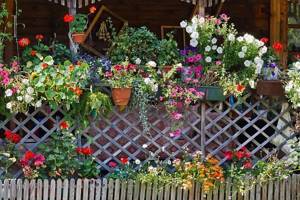
Decor in front of the house
Wooden fences
Wood fences are still very popular. Firstly, they look aesthetically attractive. Secondly, a picket fence is quite easy to erect. This option cannot be called the cheapest, but it is environmentally friendly.
This solution has the only drawback - fragility.
The photo shows a wooden picket fence.

Wooden picket fence for the front garden
Under the influence of unfavorable external factors, wood tends to deteriorate (rot). To prevent this, the lumber is pre-treated. Paint or varnish is ideal for these purposes. Such a fence will last as long as possible and will have an attractive appearance.
A beautiful fence for your front garden can be made in various designs:
- continuous canvas;
- with small holes between the wooden elements.
Installation of this fence is quite easy:
- Load-bearing pillars are dug in around the perimeter at a distance of no more than 3 meters.
- The dug pillars are connected to each other by horizontal logs.
- Picket fences are installed on horizontal logs using nails or self-tapping screws.
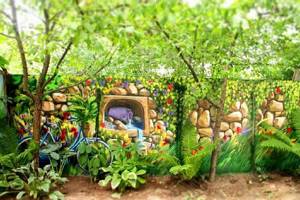
Front garden on the site
From a metal picket fence
Metal fences for your front garden have many advantages. The reasons for choosing an iron fence are:
- The fence gives a feeling of transparency and security at the same time.
- A variety of shapes, sizes and colors, thanks to which you can make your own flower garden unique.
- Fences and railings made of metal are much stronger than wood.
For a metal front garden, it is better to use high-quality material so that it lasts as long as possible and does not corrode.
The photo shows a metal picket fence.
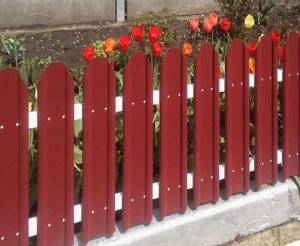
Metal picket fence for the front garden
You can install this type of fence for your front garden yourself. Installation of a metal picket fence is carried out as follows:
- the perimeter is marked, and the places intended for load-bearing supports are marked;
- ready-made metal sections or each picket fence are mounted separately on the dug-in supports;
- if metal rods or reinforcement are used to construct the fence, then it is best to weld these elements to the base of the supports.
When building a front garden in front of a house, it is best to use stainless steel so that the metal does not corrode. It can also be painted to make it look more appropriate against the backdrop of wildlife.
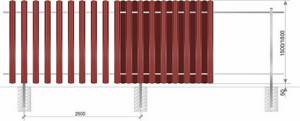
Installation diagram for a picket fence for a front garden
Forged
Many people prefer to choose a forged fence for their front garden, as forging looks incredibly beautiful and fits harmoniously into the overall landscape. The main advantage of this solution is that forged fencing can be ordered according to your individual design. You can also buy ready-made forged structures. With such a fence, the flower garden will be transformed, and the fence will fulfill its intended purpose.
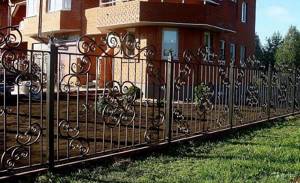
There are a lot of options for ready-made forged fences; you can purchase a ready-made structure at specialized retail outlets. A forged fence has practically no disadvantages, of course, besides the price.
If you want to order a unique sample based on your design, you will have to fork out some money.
This type of fencing is installed in the same way as the previous ones: load-bearing posts are dug along the perimeter of the flower bed, after which the forged structure is welded to them.
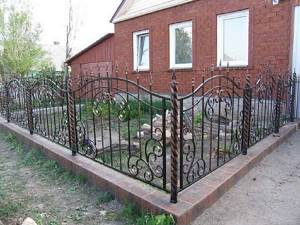
Wrought iron fence near the front garden
From corrugated sheets
Another type of metal fence, only this time - from a profile pipe or metal sheets. The main advantages include:
- ease of assembly;
- strength and durability of the material;
- favorable price and so on.
However, before choosing this solution, it is worth considering that such fences for front gardens will hide all their beauty.

Corrugated sheeting can be chosen in different colors, textures and thicknesses. Modern manufacturers of profiled sheets offer products with applied wood texture.
DIY fences for the front garden. What is a front garden? This is a small garden that is located next to a hedge. This is also an interesting solution that will catch your eye and look very beautiful. Those who prefer the classic to everything else will use a wooden fence as a front garden fence, while others will choose a structure made of brick or mesh. But in fact, there are many options, and much depends on the creativity and imagination of the gardener.
Advantages and disadvantages
Structures made from profile pipes are not inferior in strength characteristics to fences made of brick.
Expert opinion
Vladimir Ulyanov
I have been involved in fences for over 10 years, answering questions and helping people cope with the installation task on their own.
Ask a question to an expert
With properly installed fencing and periodic anti-corrosion treatment, such fencing can last at least 50 years.
The choice of colors, including the possibility of combining with other materials, for example, profiled sheets, allows you to implement the most daring projects.
A fence made from a profile pipe is not able to provide complete protection from prying eyes, but there are also positive aspects to this, in particular, along such a metal fence made from a profile pipe, shrubs are planted or covered using facing panels made of plastic or metal.
Useful Methods for fastening chain-link mesh to a profile pipe and wooden posts
Meanwhile, such fences require careful and regular maintenance, which will help prevent rust.
Preparation. Material selection
When choosing the best option for the material for the fence that you want to install in your front garden, consider the following criteria:
- Lifetime.
- Aesthetic parameters.
- Ease of processing.
- Low maintenance requirements.
- Installation duration.
- Possibility of using fasteners and devices.
- Cost of work and materials.
Make sure that everything is done in the same style and is in harmony with the design of the site. There are many ways to make a fence between the road and house areas, and at the same time give a beautiful look. But first, select the material, and only after that you can begin preparing the sketch.
Metal
Forged fences
Of all types of fences, you can make fencing from forged metal with your own hands and they will be the most durable. These structures withstand the negative effects of weather conditions and are also resistant to mechanical damage. The design is carried out in such a way that these fences will also be a serious obstacle to those who want to enter the site illegally.
Another advantage is that the material is low maintenance. These surfaces do not need to be painted every year, and buyers have a huge selection of textures and colors. You can also use different patterns to create a unique design.
Please note that if you want a unique design, you will have to spend a lot of money, but it is worth it.
There are several types of fencing based on forged metal:
- Standard ones that act as fencing. This type of fence consists of monolithic sections that are joined by welding. Metal decorations can be secured in spans with screw fastenings.
- With a beautiful design, which are most often made only to order. To create such a fence, you need to develop an individual sketch. Most often, the connection is made with clamps. Welding and stamping technology is used only at the request of the customer.
- A combined type of fencing that perfectly combines both protective and decorative functions. When creating such fences, the twisting technique is used, i.e. the metal is bent, and fastening with clamps and forge soldering is used.
From a metal picket fence
Yes, as already mentioned, metal fences have many advantages. It is worth choosing an iron fence for the following reasons:
- The fence gives a feeling of security and transparency at the same time.
- Many sizes, shapes and colors, due to which your flower garden will not look like one of many of the same type.
- Metal fences and barriers are many times stronger than wooden ones.
For such a fence, you should use only high-quality material so that it serves you as long as possible and does not succumb to corrosion. The photo shows a metal fence for the front garden.
Important! The pillars must be placed at a great distance from each other, otherwise the sections will not be stable and even ordinary gusts of wind can lead to distortion.
You can install this type of fence with your own hands. To do this, follow the following instructions:
- Make markings around the perimeter and mark those places that are intended for load-bearing supports.
- Install ready-made metal sections onto dug-in supports, or install each picket fence separately.
- If reinforcement or metal rods will be used during construction, weld the elements to the base of the supports.
The best option would be to use stainless steel so that the metal is 100% corrosion-free. It can also be painted, thereby highlighting the beauty of the structure.
Corrugated sheet
Structures made from corrugated sheets are distinguished by a modern design, which perfectly copes with the main task - to provide protection to the house.
Such fences have many positive aspects:
- Excellent performance, low maintenance requirements.
- Excellent sound insulation parameters.
- Modern design with a large selection of colors and styles for decoration. Metal profile structures have the same advantages.
- Profitable price.
A modern fence made of corrugated sheets is a simple structure, which for the most part consists of two parts - a frame, which in turn includes supports and sections. Models of fencing for front gardens made of corrugated board differ from each other in the features of the frame and the types of material used for preparation. Installation is very simple. Typically, during assembly, metal sheets are screwed to dug-in supports using roofing screws.
Helpful advice! Do not make the fence too high so as not to hide the beauty of the flower garden.
Mesh
Fences for the front garden in front of the house made from chain-link mesh are incredibly popular. Iron brackets are used for installation. Most often, sections are secured using welding technology. If you use this method when connecting to a pole, it will be maximum reliability. A wire needs to be stretched over the mesh and passed through the cells. Thanks to this simple action, the fence will keep its shape.
If you install the mesh in the corners, it will look presentable. It’s easy to transform such a fence and turn it into a hedge. This is an ideal solution for the summer season; all that remains is to plant vegetation that tends to curl and weave along the fence. This way you will not hide the beauty of the front garden, and the access of sunlight to the plants will not be blocked.
But there are also certain disadvantages:
- Homeliness.
- Over time, the mesh still loses its appearance and may bend or stretch.
- It is difficult to paint.
When choosing a mesh, focus on the galvanized coating of the material. Thanks to this, there will be no corrosion, which means the fence will last longer.
Euro picket fence
If we talk about differences, the Euro picket fence has practically no differences from the standard material. The top of such fences has a horizontal cut or a rounded edge. Using a horizontal strip, the entire upper ends with a rounded edge are covered. The edges must be rolled. All elements are molded and processed.
A little about the profile sheet
But first, I would like to list you the obvious advantages of a fence made of metal corrugated sheets, so that you have no doubt that you have made the right choice in favor of this material:
- reliability of the corrugated sheet, which is explained by its corrugated shape;
- height of the structure at the owner’s choice;
- durability of the fence;
- repair of any individual element;
- wide selection of colors.
Installing a corrugated fence yourself is a personal challenge, but if you carefully follow the instructions and recommendations, then you can experience all of the above advantages for yourself.
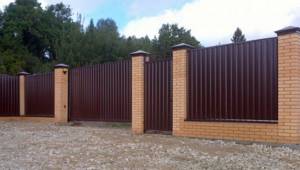
Corrugated sheeting - quickly and inexpensively
First, let's decide on a work plan:
- Territory marking and material calculation
- Materials and tools
- Fence assembly and installation technology
- Additional elements and their installation
- Care and operation of the fence
Video review of a fence made of corrugated sheets
Unusual options - hedges and wicker fencing
Owners of summer cottages try by any means to improve the properties that belong to them. Summer residents try to realize their ideas when decorating their backyard territory. Among the most effective options for decoration, we note a hedge, which must be created from ornamental plants.
But when creating, consider the following points:
- Give preference only to unpretentious plants that are able to form a voluminous crown.
- Create the optimal distance between plants.
- Fertilize and water the hedge in a timely manner.
- Don't forget to trim the bushes.
Wicker fences look presentable and natural. A great idea is to use willow twigs or thin branches of fruit trees. But since willow twigs are considered the most flexible, there will be no difficulties in using them. To begin with, the twigs should be steamed in hot water so that they are very flexible.
Ready-made structures - price
The price largely depends on the cost of the material used and the dimensions of the structure:
- Wood will cost from 10 to 13 rubles per piece (i.e. for 1 m 3 it will be about 3,400 rubles).
- A Euro fence fence will cost you about 50 rubles apiece (with a length of 1.5 meters and a width of 12.5 cm).
- A PVC fence costs from 1,850 rubles per linear meter.
It is more profitable to order material directly from suppliers rather than through stores. Please note that prices may differ from those indicated above.
